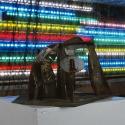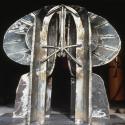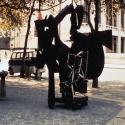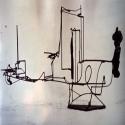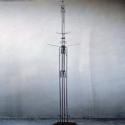Goto, Joseph
"During the war I went to the Honolulu Academy of Arts and studied drawing. I was interested in art but not seriously - just as a hobby. I did some watercolor. After the war, I was accepted at the Art Institute of Chicago. I wasn't very serious when I started. I wanted to be a painter. I was majoring in painting and drawing and minoring in printmaking and ceramics. Then I got introduced to steel sculpture during my last year - it got me all excited about being a sculptor. I had lots of encouragement; the Museum of Modern Art bought a piece in Chicago and I got a grant and a fellowship. That kept me going, and I began to work harder. I worked in Chicago for awhile and won some prizes. lots of enthusiasm and encouragement in Chicago.
From Chicago I went to Virginia to teach. I taught there for a year and then went to the University of Michigan. From Michigan I came to Rhode Island.
I think what made me go into steel sculpture is that I had a background in steel work. I worked for the Army Engineers and the Red Hill underground project. I knew something about rigging and steel work. My last sculpture is steel work. It's not welded sculpture; it's not sheet metal work; it's solid steel. I feel like a steel worker when I'm working with sculpture. I work in steel plate.
The reason for switching from small steel sculpture to large scale is that I was not using my potential. I like to related my work to sculpture and not objects. My concept of steel is to use it for sculpture purposes and not as industrial objects. I've welded industrial objects - tanks and such - very beautiful in themselves. But they don't call such things sculpture; they call them whatever they are. There's a purpose to them, whereas my things have no purpose. They just sit there. I try to get as far away as I can from industrial things.
Cutting the steel is like carving, as in the Matisse and Picasso cutouts. It's not mechanical. It's not a logical thing that you learn; it comes from long experience. It's the feeling of being right, but not the right calculations. It goes beyond calculations, and so you can't repeat it.
It gives me a good feeling to build things."
Joseph Goto, from "Artists of Hawaii," 1977
Gallery of Selected Works
Selected Documents
- Artist Resume
- Artist Statement on Steel Work Experiences
- Exhibition Catalog for "Joseph Goto", Zabriskie Gallery, New York City, 1973
- Artist Statement
- Exhibition press release for "Betrayal / Empowerment I", Asian American Arts Centre, 1994
- Exhibition flyer and poster for "The AAAC Story", Asian American Arts Centre, 2002
- Exhibition press release for "The AAAC Story", Asian American Arts Centre, 2002
- Exhibition flyer for "Betrayal / Empowerment", Asian American Arts Centre and Columbia University Teachers College, 1994
Other Links
View artist folder list at Asian American Arts Centre

